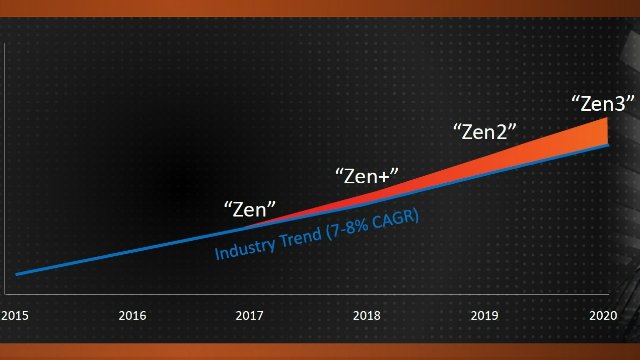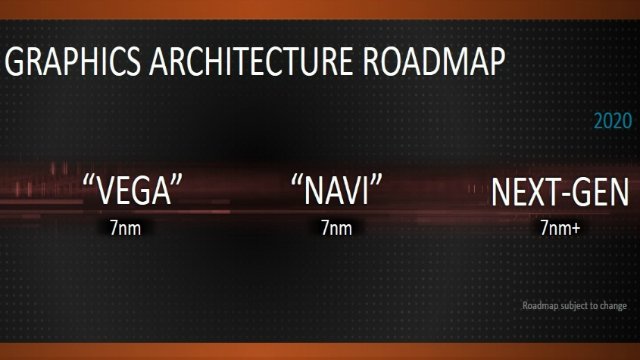AMD revealed its upcoming product lineup at CES 2018 yesterday. Second-generation Ryzen processors, the Zen+ line, a new Threadripper, Zen 2 and 3, and the 7nm Vega and Navi GPUs were all discussed at the presentation. A surprise showing of two Ryzen APUs with integrated Vega graphics was welcome as well, showing that AMD means it when it says it intends to be a serious rival to Intel once again.
The core theme of the presentation is that AMD intends to regain its reputation for fast, cost-effective chips. The company plans to rededicate itself to high-performance computing, and if the products revealed are any indicator, it just might happen for them.
Zen+ Release Date
The next desktop enthusiast CPUs to be released by AMD will be Zen+. This second-generation Ryzen will release in April 2018 and ditch the 14nm fabrication process in favor of a new 12nm one. No specific models were revealed, but AMD did reveal that Zen+ would definitely clock higher than the first-gen chips. Estimates right now seem to indicate that Zen+ will have at least a 10% performance increase over comparable Ryzen first-gen models.
Zen+ will premiere the new Precision Boost 2 frequency control, as well as the XFR2 clockspeed booster, which should allow for more precision with overclocking. The upcoming CPUs will have a larger and better cache, allow for higher speed memory, and reduce latency.
Ryzen APUs
The first-generation Ryzen CPUs didn’t offer discrete graphics like Intel’s core processors do, but AMD is rectifying that with two Ryzen APUs that will be separate from the Zen+ lineup.
| MODEL | CPU CORES | THREADS | MAX BOOST CLOCK (GHZ) | GRAPHICS COMPUTE UNITS1 | MAX GPU CLOCK (MHZ) | L2/L3 CACHE (MB) | CTDP (WATTS) |
|---|---|---|---|---|---|---|---|
| RYZEN™ 5 2400G WITH RADEON™ RX VEGA11 GRAPHICS | 4 | 8 | 3.9 | 11 | 1250 | 6 | 45-65W |
| RYZEN™ 3 2200G WITH RADEON™ VEGA8 GRAPHICS | 4 | 4 | 3.7 | 8 | 1100 | 6 | 45-65W |
The Ryzen 5 2400G will replace the Ryzen 5 2400 and feature four cores with simultaneous multithreading (SMT). The 2400G will have a base clock of 3.6GHz and a boost clock of 3.9GHz. The integrated graphics will include 11 Vega-based Computer Units. The APU will retail for $169.
The Ryzen 3 2200G will have four cores, but not have the SMT capabilities of the 2400G. It will run at a base clock of 3.5GHz, and a max boost of 3.7GHz. It will have 8 Vega Computer Units and retail for $99.
Both APUs are compatible with existing X300 chipset motherboards compatible with the rest of the first-gen Ryzen lineup. The Ryzen 5 2400G should perform similarly to an Intel i5-8400 and a GeForce GT 1030, so not the greatest, but with the potential to make a decent low-end HTPC.
Zen 2 and Zen 3 Release Dates and Roadmap
AMD users are going to have to be satisfied with Zen+ for this year. AMD projects that the true successor of Ryzen, Zen 2, won’t release until sometime in 2019. Zen 2 will use a 7nm fabrication process, which should point to them being more energy efficient at the very least. Zen 3 can be expected a year later in 2020 and should be manufactured with an improved version of the 7nm process that will be used with Zen 2.

Usually, each generation of CPU (at least when it comes to Intel) has given roughly a 7-8% increase in performance. Although Zen 2 and Zen 3 are too far off to speculate in any precise way, AMD stated that the chips should offer “far more” than the typical bump you see in between CPU generations.
Zen+ Second-Generation Threadripper
AMD is working on a new iteration of its Threadripper line for release sometime in the second half of 2018. It’s likely that the second-generation Threadripper processors will be manufactured with the same 12nm process that Zen+ will be. Details on specific models and performance was unavailable at the conference.
7nm Vega, Navi, and Next-Gen CPUs
The first-gen Vega cards have been a nightmare to get a hold of, so gamers won’t be happy to hear that the second-generation Vega cards due out this year aren’t intended for the enthusiast market. Instead, they’ll be targeted towards machine-learning applications.

It’s not known if or when consumer-grade 2nd-gen Vega cards will debut, but there’s a chance that gamers won’t get another card until the 7nm Navi GPUs debut in 2019. No real details were available for Navi, or the unnamed Next-Gen 7nm+ GPUs that are set to debut in 2020.
Ryzen Pro Mobile Processors with Radeon Vega Graphics
| MODEL | CPU CORES | THREADS | MAX CLOCK (GHZ) | GRAPHICS COMPUTE UNITSIII | MAX GPU CLOCK (MHZ) | L2/L3 CACHE (MB) | CTDP (WATTS) |
|---|---|---|---|---|---|---|---|
| RYZEN™ 7 PRO 2700U WITH RADEON™ VEGA10 GRAPHICS | 4 | 8 | 3.8 | 10 | 1300 | 6 | 15W Nominal |
| RYZEN™ 5 PRO 2500U WITH RADEON™ VEGA8 GRAPHICS | 4 | 8 | 3.6 | 8 | 1100 | 6 | 15W Nominal |
| RYZEN™ 3 PRO 2300U WITH RADEON™ VEGA6 GRAPHICS | 4 | 4 | 3.4 | 6 | 1100 | 6 | 15W Nominal |
Intel partnered with AMD to make a module containing an Intel CPU and AMD GPU for laptops, but AMD isn’t stopping its mobile offerings there. A new Radeon Vega Mobile GPU equipped with HBM2 memory was revealed at AMD’s conference and will be used alongside Ryzen CPUs for ultrabooks with an emphasis on gaming.







